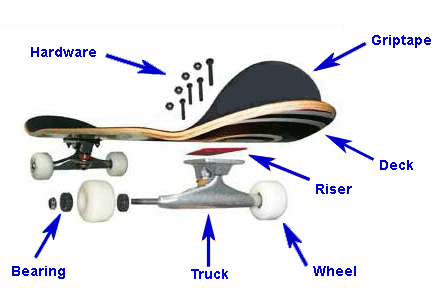


Basic Skateboard Diagram
If you're new to the world, of skateboarding, Welcome! This diagram to the left shows a blueprint for the various parts of a skateboard, and what it is composed of. The main component is the skateboard deck. This is several treated layers of wood compressed in a specific order, which are then placed into a hydraulic press and melded together by an adhesive. The standard skateboards come in widths of 7.75" to 8.75". Next, a graphic is added to the bottom of the deck. Griptape is essentially a sand paper-like sticker which the skater places on the top of the board. This aids in providing traction while the skater is riding it. Two metal units called trucks are held in place and secured to the bottom of the board by two sets of four screws called hardware. You can place a piece of square plastic called a riser pad in between the board and trucks if you'd like more height, but this is not a necessary addition unless, when ridden, larger wheels added to the board scrape against its bottom. The purpose of trucks are to allow the skater to successfully make turns by leaning slightly to the left or to the right. The tighter the trucks are adjusted, the less ability the skater has to turn. The trucks also function as a platform to attach the wheels for movement. Skateboard wheels are made of polyurethane, and range in size from 50mm-59mm. Anything larger is meant for a much bigger setup, called a longboard. Without bearings however, the wheels would not rotate as freely. The better bearings, the easier it is for the wheels to rotate.
Goofy Versus Regular
As far as boardsports go, these two terms universally mean the same thing, whether you're talking about surfing, snowboarding, longboarding, or skateboarding. The word "Goofy" refers to when a skater stands on their board with their right foot at the front, and their left foot closer to the back end of the board. The word "Regular" refers to when a skater stands on their board with their left foot at the front, and their right foot closer to the back end of the board. If you're not sure which one might be most comfortable, there are a few ways to decide which you are there are a few tests.
1. The Stairs Test: Whichever foot you use to first step onto a set of stairs from the bottom just might be the foot you feel most comfortable with having forward on a skateboard.
2.) The Lean Test: Start by standing with you feet shoulder with apart and begin to slowly lean forward. Eventually, you will need to step out with one leg to catch yourself, and this is often the stronger leg.

Skateboarding Styles
Here are some of the most popular styles of skateboarding out there today.


Freestyle
Freestyle is skating is probably the oldest style out there. It was invented in the 50's and 60's to give surfers something to do when the wave conditions were less than ideal. The style continued to grow over the decades thanks to skaters like Russ Howell (pictured left) and Rodney Mullen.
Vert Skating
Born out of skaters zooming around empty swimming pools in the 1970s, vert skating is when a skateboarder rides back and forth on a vertical ramp, launching into the air and preforming acrobatically inspired stunts. Vert Skating includes a wide range of equipment. It can include anything from small quarter pipes at the skate park, to Mega Ramps that are tens of feet tall at professional competitions. (Pictured left: Lynz Adams Hawkins Pastrana shredding the X Games Half Pipe).

Street Skating
Street skating is when a skateboard uses the area and attributes of an urban or industrial environment to do tricks and make transitions. For example, a skater can grind on park benches, jump down a set of 10 stairs, or even try a Natas Spin on top of a fire hydrant. It is the most easily accessible style of skating for those located in larger cities if there is no skatepark nearby. (Pictured left: Kareem Campbell does an ollie over a construction barricade).
Click on this button to see the current stats, ranking, videos, and events for more than 18,000 skaters world-wide.


